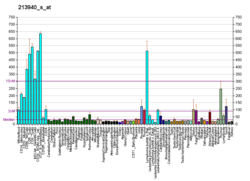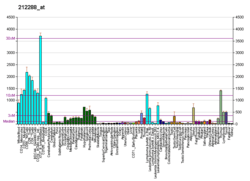FNBP1
Formin-binding protein 1 is a protein that in humans is encoded by the FNBP1 gene.[5][6][7]
Function
The protein encoded by this gene is a member of the formin-binding-protein family. The protein contains an N-terminal Fer/Cdc42-interacting protein 4 (CIP4) homology (FCH) domain followed by a coiled-coil domain, a proline-rich motif, a second coiled-coil domain, a Rho family protein-binding domain (RBD), and a C-terminal SH3 domain. This protein binds sorting nexin 2 (SNX2), tankyrase (TNKS), and dynamin; an interaction between this protein and formin has not been demonstrated yet in human.[7]
Interactions
FNBP1 has been shown to interact with:
gollark: ++apioform
gollark: ++apioform
gollark: ++apioform
gollark: ++apioform
gollark: ++apioform
References
- GRCh38: Ensembl release 89: ENSG00000187239 - Ensembl, May 2017
- GRCm38: Ensembl release 89: ENSMUSG00000075415 - Ensembl, May 2017
- "Human PubMed Reference:". National Center for Biotechnology Information, U.S. National Library of Medicine.
- "Mouse PubMed Reference:". National Center for Biotechnology Information, U.S. National Library of Medicine.
- Nagase T, Ishikawa K, Miyajima N, Tanaka A, Kotani H, Nomura N, Ohara O (Aug 1998). "Prediction of the coding sequences of unidentified human genes. IX. The complete sequences of 100 new cDNA clones from brain which can code for large proteins in vitro". DNA Res. 5 (1): 31–9. doi:10.1093/dnares/5.1.31. PMID 9628581.
- Fuchs U, Rehkamp G, Haas OA, Slany R, Kōnig M, Bojesen S, Bohle RM, Damm-Welk C, Ludwig WD, Harbott J, Borkhardt A (Jul 2001). "The human formin-binding protein 17 (FBP17) interacts with sorting nexin, SNX2, and is an MLL-fusion partner in acute myelogeneous leukemia". Proc Natl Acad Sci U S A. 98 (15): 8756–61. doi:10.1073/pnas.121433898. PMC 37508. PMID 11438682.
- "Entrez Gene: FNBP1 formin binding protein 1".
- Larocca MC, Shanks RA, Tian L, Nelson DL, Stewart DM, Goldenring JR (Jun 2004). "AKAP350 interaction with cdc42 interacting protein 4 at the Golgi apparatus". Mol. Biol. Cell. 15 (6): 2771–81. doi:10.1091/mbc.E03-10-0757. PMC 420101. PMID 15047863.
- Kamioka Y, Fukuhara S, Sawa H, Nagashima K, Masuda M, Matsuda M, Mochizuki N (Sep 2004). "A novel dynamin-associating molecule, formin-binding protein 17, induces tubular membrane invaginations and participates in endocytosis". J. Biol. Chem. 279 (38): 40091–9. doi:10.1074/jbc.M404899200. PMID 15252009.
- Ghadimi MP, Sanzenbacher R, Thiede B, Wenzel J, Jing Q, Plomann M, Borkhardt A, Kabelitz D, Janssen O (May 2002). "Identification of interaction partners of the cytosolic polyproline region of CD95 ligand (CD178)". FEBS Lett. 519 (1–3): 50–8. doi:10.1016/s0014-5793(02)02709-6. PMID 12023017.
- Fuchs U, Rehkamp GF, Slany R, Follo M, Borkhardt A (Nov 2003). "The formin-binding protein 17, FBP17, binds via a TNKS binding motif to tankyrase, a protein involved in telomere maintenance". FEBS Lett. 554 (1–2): 10–6. doi:10.1016/s0014-5793(03)01063-9. PMID 14596906.
Further reading
- Richnau N, Aspenström P (2001). "Rich, a rho GTPase-activating protein domain-containing protein involved in signaling by Cdc42 and Rac1". J. Biol. Chem. 276 (37): 35060–70. doi:10.1074/jbc.M103540200. PMID 11431473.
- Ghadimi MP, Sanzenbacher R, Thiede B, Wenzel J, Jing Q, Plomann M, Borkhardt A, Kabelitz D, Janssen O (2002). "Identification of interaction partners of the cytosolic polyproline region of CD95 ligand (CD178)". FEBS Lett. 519 (1–3): 50–8. doi:10.1016/S0014-5793(02)02709-6. PMID 12023017.
- Fujita H, Katoh H, Ishikawa Y, Mori K, Negishi M (2003). "Rapostlin is a novel effector of Rnd2 GTPase inducing neurite branching". J. Biol. Chem. 277 (47): 45428–34. doi:10.1074/jbc.M208090200. PMID 12244061.
- Katoh M, Katoh M (2004). "FNBP2 gene on human chromosome 1q32.1 encodes ARHGAP family protein with FCH, FBH, RhoGAP and SH3 domains". Int. J. Mol. Med. 11 (6): 791–7. doi:10.3892/ijmm.11.6.791. PMID 12736724.
- Fuchs U, Rehkamp GF, Slany R, Follo M, Borkhardt A (2003). "The formin-binding protein 17, FBP17, binds via a TNKS binding motif to tankyrase, a protein involved in telomere maintenance". FEBS Lett. 554 (1–2): 10–6. doi:10.1016/S0014-5793(03)01063-9. PMID 14596906.
- Larocca MC, Shanks RA, Tian L, Nelson DL, Stewart DM, Goldenring JR (2004). "AKAP350 Interaction with cdc42 Interacting Protein 4 at the Golgi Apparatus". Mol. Biol. Cell. 15 (6): 2771–81. doi:10.1091/mbc.E03-10-0757. PMC 420101. PMID 15047863.
- Brill LM, Salomon AR, Ficarro SB, Mukherji M, Stettler-Gill M, Peters EC (2004). "Robust phosphoproteomic profiling of tyrosine phosphorylation sites from human T cells using immobilized metal affinity chromatography and tandem mass spectrometry". Anal. Chem. 76 (10): 2763–72. doi:10.1021/ac035352d. PMID 15144186.
- Kamioka Y, Fukuhara S, Sawa H, Nagashima K, Masuda M, Matsuda M, Mochizuki N (2004). "A novel dynamin-associating molecule, formin-binding protein 17, induces tubular membrane invaginations and participates in endocytosis". J. Biol. Chem. 279 (38): 40091–9. doi:10.1074/jbc.M404899200. PMID 15252009.
- Beausoleil SA, Jedrychowski M, Schwartz D, Elias JE, Villén J, Li J, Cohn MA, Cantley LC, Gygi SP (2004). "Large-scale characterization of HeLa cell nuclear phosphoproteins". Proc. Natl. Acad. Sci. U.S.A. 101 (33): 12130–5. doi:10.1073/pnas.0404720101. PMC 514446. PMID 15302935.
- Rush J, Moritz A, Lee KA, Guo A, Goss VL, Spek EJ, Zhang H, Zha XM, Polakiewicz RD, Comb MJ (2005). "Immunoaffinity profiling of tyrosine phosphorylation in cancer cells". Nat. Biotechnol. 23 (1): 94–101. doi:10.1038/nbt1046. PMID 15592455.
- Zhou FL, Zhang WG, Chen G, Zhao WH, Cao XM, Chen YX, Tian W, Liu J, Liu SH (2006). "Serological identification and bioinformatics analysis of immunogenic antigens in multiple myeloma". Cancer Immunol. Immunother. 55 (8): 910–7. doi:10.1007/s00262-005-0074-x. PMID 16193335.
- Qian J, Chen W, Lettau M, Podda G, Zörnig M, Kabelitz D, Janssen O (2006). "Regulation of FasL expression: a SH3 domain containing protein family involved in the lysosomal association of FasL". Cell. Signal. 18 (8): 1327–37. doi:10.1016/j.cellsig.2005.10.015. PMID 16318909.
- Itoh T, Erdmann KS, Roux A, Habermann B, Werner H, De Camilli P (2006). "Dynamin and the actin cytoskeleton cooperatively regulate plasma membrane invagination by BAR and F-BAR proteins". Dev. Cell. 9 (6): 791–804. doi:10.1016/j.devcel.2005.11.005. PMID 16326391.
- Tsujita K, Suetsugu S, Sasaki N, Furutani M, Oikawa T, Takenawa T (2006). "Coordination between the actin cytoskeleton and membrane deformation by a novel membrane tubulation domain of PCH proteins is involved in endocytosis". J. Cell Biol. 172 (2): 269–79. doi:10.1083/jcb.200508091. PMC 2063556. PMID 16418535.
This article is issued from Wikipedia. The text is licensed under Creative Commons - Attribution - Sharealike. Additional terms may apply for the media files.






